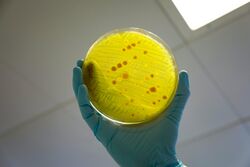Biology:Multidrug-resistant bacteria
Multidrug-resistant bacteria (MDR bacteria) are bacteria that are resistant to three or more classes of antimicrobial drugs.[1] MDR bacteria have seen an increase in prevalence in recent years[clarification needed][2] and pose serious risks to public health. MDR bacteria can be broken into 3 main categories: Gram-positive, Gram-negative, and other (acid-stain). These bacteria employ various adaptations to avoid or mitigate the damage done by antimicrobials. With increased access to modern medicine there has been a sharp increase in the amount of antibiotics consumed.[3] Given the abundant use of antibiotics there has been a considerable increase in the evolution of antimicrobial resistance factors, now outpacing the development of new antibiotics.[4]
Examples identified as serious threats to public health
Examples of MDR bacteria identified as serious threats to public health include:[5]
- Gram-positive MDR bacteria
- Gram-negative MDR bacteria
- Carbapenem-resistant Acinetobacter
- Escherichia coli
- Klebsiella pneumoniae
- Neisseria gonorrhoeae
- Campylobacter
- Pseudomonas aeruginosa
- Salmonella
- Shigella
- Other MDR bacteria
Microbial adaptations
MDR bacteria employ a plurality of adaptations to overcome the environmental insults caused by antibiotics. Bacteria are capable of sharing these resistance factors in a process called horizontal gene transfer where resistant bacteria share genetic information that encodes resistance to the naive population.[6]
- Antibiotic inactivation: bacteria create proteins that can prevent damage caused by antibiotics, they can do this in two ways. First, inactivating or modifying the antibiotic so that it can no longer interact with its target. Second, degrading the antibiotic directly.[7]
- Multidrug efflux pumps: The use of transporter proteins to expel the antibiotic.[8]
- Modification of target sites: mutating or modifying elements of the bacteria structure to prevent interaction with the antibiotic.[7]
- Structural modifications: mutating or modifying global elements of cell to adapt to Antibiotic (Such as increased acid tolerance to an acidic antimicrobial)[7]
Alternative antimicrobial methods
Phage therapy
Bacteriophage therapy, commonly known as 'phage therapy,' uses bacteria-specific viruses to kill antibiotic resistant bacteria. Phage therapy offers considerably higher specificity as the phage can be engineered to only infect a certain bacteria species.[9] Phage therapy also allows for the possibility of biofilm penetration in cases where antibiotics are ineffective due to the increased resistance of biofilm-forming pathogens.[9] One major drawback to phage therapy is the evolution of phage-resistant microbes which was seen in a majority of phage therapy experiments aimed to treat sepsis and intestinal infection.[10] Recent studies suggest that development of phage resistance comes as a trade-off for antibiotic resistance and can be used to create antibiotic-sensitive populations.[10][11]
References
- ↑ Magiorakos, A.-P.; Srinivasan, A.; Carey, R.B.; Carmeli, Y.; Falagas, M.E.; Giske, C.G.; Harbarth, S.; Hindler, J.F. et al. (March 2012). "Multidrug-resistant, extensively drug-resistant and pandrug-resistant bacteria: an international expert proposal for interim standard definitions for acquired resistance" (in en). Clinical Microbiology and Infection 18 (3): 268–281. doi:10.1111/j.1469-0691.2011.03570.x. PMID 21793988.
- ↑ Bae, Songmee; Lee, Jaehoon; Lee, Jaehwa; Kim, Eunah; Lee, Sunhwa; Yu, Jaeyon; Kang, Yeonho (January 2010). "Antimicrobial Resistance in Haemophilus influenzae Respiratory Tract Isolates in Korea: Results of a Nationwide Acute Respiratory Infections Surveillance" (in en). Antimicrobial Agents and Chemotherapy 54 (1): 65–71. doi:10.1128/AAC.00966-09. ISSN 0066-4804. PMID 19884366.
- ↑ Sample, Ian (2018-03-26). "Calls to rein in antibiotic use after study shows 65% increase worldwide" (in en-GB). The Guardian. ISSN 0261-3077. https://www.theguardian.com/science/2018/mar/26/calls-to-rein-in-antibiotic-use-after-study-shows-65-increase-worldwide.
- ↑ Ventola, C. Lee (April 2015). "The antibiotic resistance crisis: part 1: causes and threats". P & T: A Peer-Reviewed Journal for Formulary Management 40 (4): 277–283. ISSN 1052-1372. PMID 25859123.
- ↑ CDC (2020-10-28). "Antibiotic-resistant Germs: New Threats" (in en-us). https://www.cdc.gov/drugresistance/biggest-threats.html.
- ↑ Arnold, Brian J.; Huang, I-Ting; Hanage, William P. (April 2022). "Horizontal gene transfer and adaptive evolution in bacteria" (in en). Nature Reviews Microbiology 20 (4): 206–218. doi:10.1038/s41579-021-00650-4. ISSN 1740-1526. PMID 34773098. https://www.nature.com/articles/s41579-021-00650-4.
- ↑ 7.0 7.1 7.2 Munita, Jose M.; Arias, Cesar A. (April 2016). "Mechanisms of Antibiotic Resistance". Microbiology Spectrum 4 (2). doi:10.1128/microbiolspec.VMBF-0016-2015. ISSN 2165-0497. PMID 27227291.
- ↑ Du, Dijun; Wang-Kan, Xuan; Neuberger, Arthur; van Veen, Hendrik W.; Pos, Klaas M.; Piddock, Laura J. V.; Luisi, Ben F. (September 2018). "Multidrug efflux pumps: structure, function and regulation" (in en). Nature Reviews Microbiology 16 (9): 523–539. doi:10.1038/s41579-018-0048-6. ISSN 1740-1534. PMID 30002505. https://www.nature.com/articles/s41579-018-0048-6.
- ↑ 9.0 9.1 Lin, Derek M; Koskella, Britt; Lin, Henry C (2017). "Phage therapy: An alternative to antibiotics in the age of multi-drug resistance" (in en). World Journal of Gastrointestinal Pharmacology and Therapeutics 8 (3): 162–173. doi:10.4292/wjgpt.v8.i3.162. ISSN 2150-5349. PMID 28828194.
- ↑ 10.0 10.1 Oechslin, Frank (2018-06-30). "Resistance Development to Bacteriophages Occurring during Bacteriophage Therapy" (in en). Viruses 10 (7): 351. doi:10.3390/v10070351. ISSN 1999-4915. PMID 29966329.
- ↑ Chan, Benjamin K.; Sistrom, Mark; Wertz, John E.; Kortright, Kaitlyn E.; Narayan, Deepak; Turner, Paul E. (July 2016). "Phage selection restores antibiotic sensitivity in MDR Pseudomonas aeruginosa" (in en). Scientific Reports 6 (1): 26717. doi:10.1038/srep26717. ISSN 2045-2322. PMID 27225966. Bibcode: 2016NatSR...626717C.
 |


